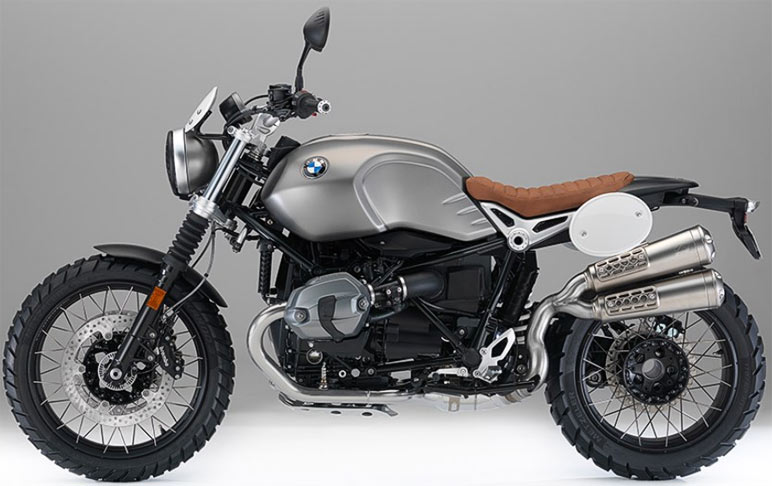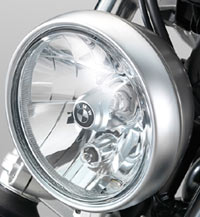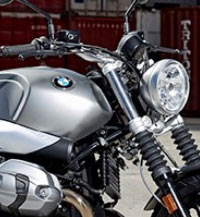
    

BMW R nineT Scrambler2016 model. 1170cc, OHV, air & oil-cooled Boxer twin 
▲ The Germans might well be one of the last to get the joke, but they've obviously still got a sense of fun. The big question is whether BMW took too long to clamber onto the street scrambler bandwagon. This is the 2016 model soon to be released. We're pretty certain that we won't be buying. But BMW is said to be gunning for big sales over the next year. Expect surprises.  ▲ Question: What the hell are you going to scramble over on this? Answer: Nothing. But then, this bike is instead intended to scramble under the Euro4 emissions regulations that will be with us come January 2016. We like it. Sort of. And as a bar hopper it's probably ideal. But for anything that involves time, distance or a pillion, you might want to look elsewhere. 
▲ From any angle this BMW R nineT Scrambler looks the part—provided you're into the current urban, brat scene. But we can also see a lot of guys and gals hating this motorcycle for its lack of practicality. We can see both sides, and we're staying out of it.  ▲ BMW's 1,170cc R nineT engine cutaways. This is what happens when you stick with a Boxer twin concept and develop the hell out of it. We're expecting to see many other production Beemers powered by this bag of bolts, but is the basic architecture getting too long in the tooth to stay ahead of emissions regulations? We don't know. Presumably BMW does. Either way, we'll lament the passing of this engine when it finally happens.  ▲ BMW's standard 1,170cc R nineT. Revealed in 2013, and introduced one year later, this motorcycle was (say BMW) aimed largely at the customisation set, meaning that it's easy to modify thanks to a bolt-on rear sub-frame, simple construction, and an air/oil-cooled engine (as opposed to liquid-cooled) for that authentic retro looks. But since when have customisers worried about mechanical challenges? Regardless, BMW dealers currently (Nov 2015) have these on order for customers, and the factory is struggling to keep up with demand. That's the commercial propaganda, anyway. We like this bike. But we don't love it. Copyright Sump Publishing 2015 | 
BMW's latest variation on the much lauded and sell-out R nineT theme is this new Scrambler for 2016 (eyes left everyone). The brief appears to have been a fairly simple one: cash-in quickly on the current street scrambler fad, keep the costs low, keep the quality high, ensure the bike is Euro4 gas emissions and noise compliant, and make it as funky as possible. How do we know BMW demanded all that? Because that's what we got. 
1,170cc engine The engine is BMW's current 4-valve-per-cylinder 1,170cc air & oil-cooled Boxer twin good for 110bhp at 7,550rpm. The bore is 101mm. The stroke is 73mm. There are two camshafts, a central balancer shaft and a fairly lofty 12:1 compression ratio. Maximum torque is, we hear, 85.5lbs-ft @ 6,000rpm. But if this Beemer looks lightweight, it ain't. At 484lbs (220kg) it's not as heavy as some of its rivals. However, despite the chunky tyres, the wide and high 'bars, and the twin high-level silencers, you wouldn't want to take this out on any serious, or even half-serious, dirt. Like the 2014 Roadster, the frame is steel tubing. The subframe is detachable. The overall construction is kept simple and accessible. That, we hear, is part of BMW's (misguided?) new philosophy of pandering to the customisers. There's an outsize catalytic converter fitted beneath this machine plus a carbon-capture system designed to ensure that no stray petrol fumes are allowed to escape and destroy all life on planet earth as we know it. The engine mapping has been revised to help clean up the emissions. ABS is standard (and as from January 2016 is mandated by law on all bikes above 125cc). Traction control is optional. The transmission is still 6-speed. Final drive is, of course, by BMW's Paralever shaft. Front fork and wheels The front fork is conventional on this bike (as opposed to the inverted fork on the standard R nineT). Fork travel is 125mm. Rear suspension travel is 140mm. The front wheel is a 19-incher with twin 320mm discs controlled by Brembo calipers. The rear wheel is 17-inches. Cast wheels and road tyres are standard. Wire wheels and knobblies are optional. And there will be plenty of extras rolling down the autobahn to a dealer somewhere near you. 
BMW has spent a lot of time getting the finish the way it wanted it. To our taste, it's not bad, but it leans towards the kind of design typical of straight-to-junk 1990s music systems. The double silencer set-up ain't going to win any prizes; not if we're on the judges' bench. And we don't much care for the cheap looking number boards. 
According to the factory, the fuel tank is "purist" steel as opposed to that nasty, hand-welded aluminium alloy plant pot on the standard R nineT. 

The firm hasn't yet announced prices (we're writing this in mid-November 2015, by the way). But naturally, this machine will be competitive, etc. Generally, it puts us in mind of the old R80ST (which we once owned). That bike was quite a revvy machine with an over-lightened flywheel. It was okay around town, but less than satisfactory on a run. With this new Scrambler, we're waiting with interest to find out how it's geared and whether its legs are longer rather than shorter. As for that R nineT name? We hate it. Like will.i.am or 69 Boyz, it sounds cheap, corny and trashy. Or maybe we're just getting old. 
Conclusion Overall, it looks pretty good to us, and we're confident that BMW will sell a respectable number of these. Certainly, the standard R nineT is selling faster than Semtex at an ISIS convention. But Triumph, Ducati and Moto Guzzi are coming on very strong, and there are many other hungry contenders hightailing it from the far east and ready to slug it out. The biggest issue with this bike is, we think, the weight. If it lost fifty pounds, we'd be happier. But you'd end up paying thousands for that fifty, and times are still pretty hard wherever you are in the world. |













